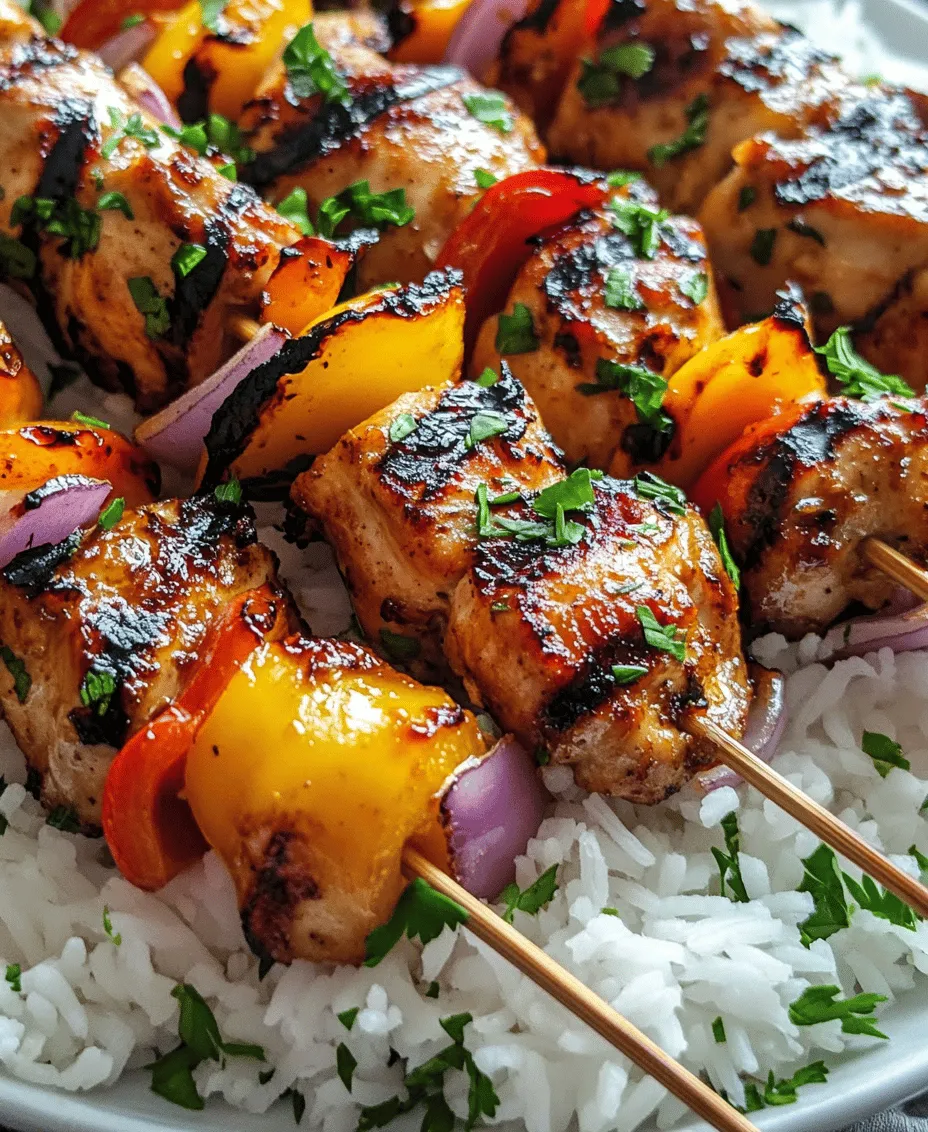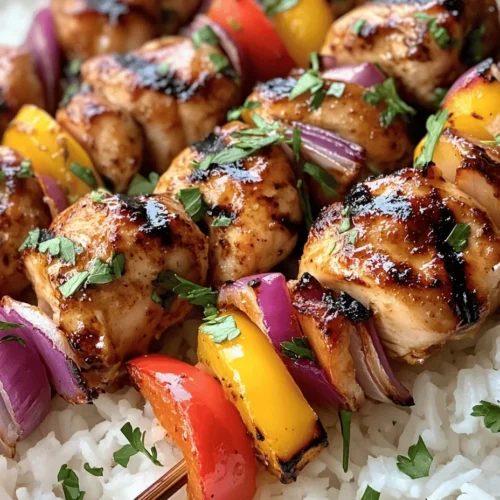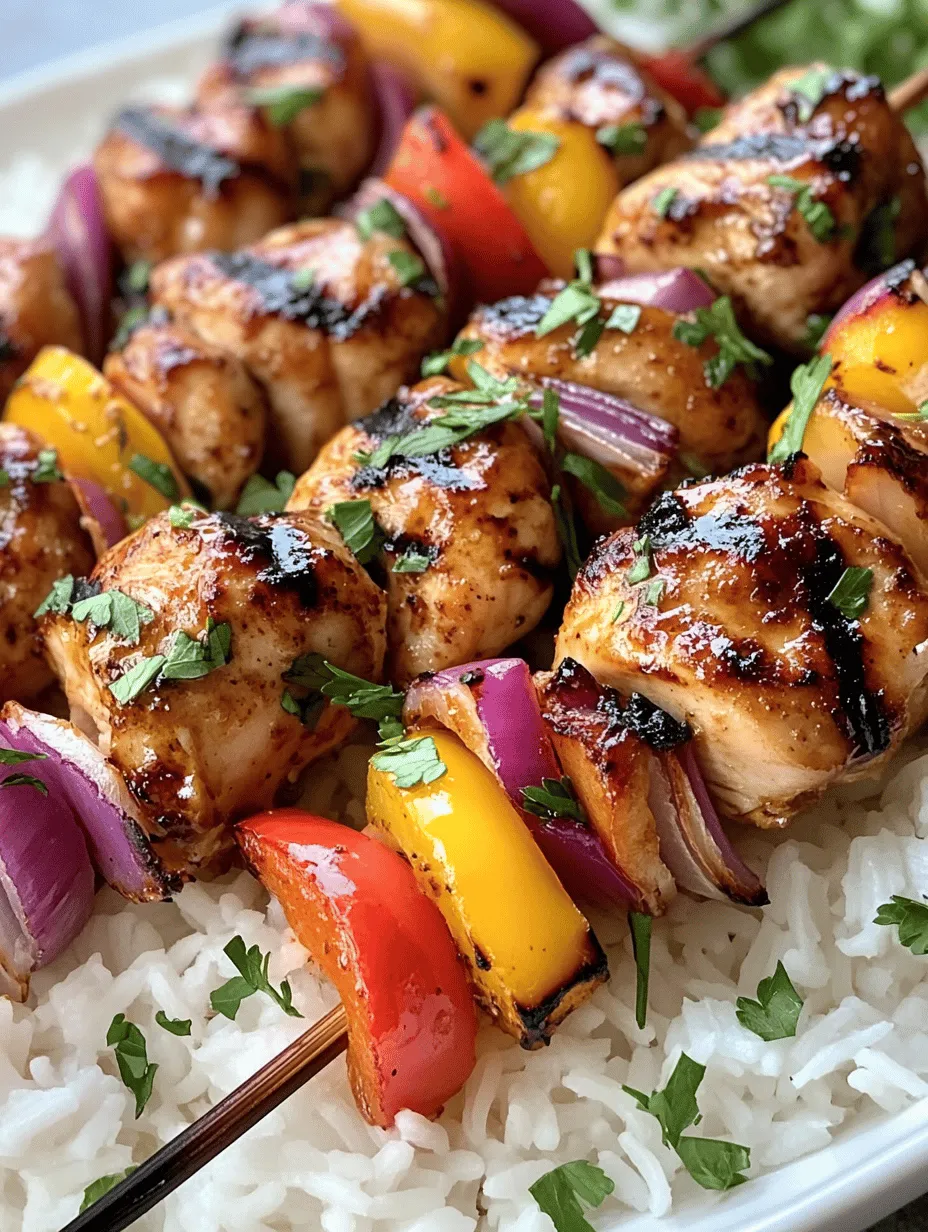Introduction
Kabobs, a beloved dish across various cuisines, have become synonymous with outdoor grilling and vibrant flavors. From Middle Eastern shish kebabs to the Southeast Asian satays, these skewered delights have captured the hearts—and appetites—of food lovers worldwide. In the realm of grilled meals, honey-garlic chicken kabobs stand out with their delightful combination of sweet and savory flavors, making them an ideal choice for family dinners, barbecues, and gatherings.
The honey-garlic chicken kabob recipe brings together tender pieces of chicken marinated in a luscious blend of honey and garlic, complemented by colorful vegetables that add both nutrition and aesthetic appeal. The grilling process caramelizes the honey, creating a beautiful glaze that not only enhances the flavor but also appeals to the eye. It’s an easy yet impressive dish that can elevate any meal, whether you’re hosting friends or enjoying a cozy dinner at home.
In this article, we will explore the essential ingredients that make up these kabobs, the importance of marinating for maximum flavor, and tips for preparing your skewers to ensure a perfect grilling experience.
Understanding the Ingredients
The success of honey-garlic chicken kabobs lies in the quality and selection of ingredients used. Each component plays a crucial role in building the flavors and textures that make these kabobs irresistible.
Boneless, Skinless Chicken Thighs
When it comes to kabobs, boneless, skinless chicken thighs are the star of the show. Unlike chicken breasts, which can dry out when grilled, thighs are higher in fat content, making them juicier and more flavorful. Their tender texture allows them to absorb marinades beautifully, enhancing the overall taste of the kabobs. Additionally, thighs are less likely to become tough or chewy when cooked at high temperatures, making them the perfect choice for grilling.
Honey
Honey serves as the sweet element that balances the savory flavors of the dish. Its natural sweetness caramelizes when grilled, creating a beautiful glaze that adds depth to the kabobs. Beyond flavor, honey also acts as a natural tenderizer, helping to keep the chicken moist during cooking. The choice of honey—whether wildflower, clover, or local honey—can subtly influence the flavor profile of your kabobs, so feel free to experiment based on your preference.
Soy Sauce
Soy sauce is a key ingredient in many marinades, and for good reason. This fermented condiment adds a rich umami flavor that enhances the overall taste of the chicken. It also provides saltiness, which helps to bring out the other flavors in the marinade. When combined with honey, soy sauce creates a delightful balance that is both savory and sweet, making it an essential component of the honey-garlic marinade.
Garlic and Ginger
Garlic and ginger are aromatics that elevate the flavor of the kabobs to new heights. Fresh garlic adds a pungent and slightly spicy note, while ginger introduces warmth and a hint of sweetness. Together, they create a fragrant base that permeates the chicken, ensuring that each bite is bursting with flavor. Using fresh, minced garlic and ginger is recommended for the best results, but powdered versions can be used in a pinch.
Sesame Oil
Sesame oil adds depth and richness to the marinade, providing a subtle nutty flavor that complements the other ingredients. It helps to round out the sweetness of the honey and the saltiness of the soy sauce, creating a well-balanced flavor profile. Additionally, sesame oil has a high smoke point, making it ideal for grilling and ensuring that the kabobs develop a lovely char without burning.
Bell Peppers and Onions
Colorful bell peppers and onions not only contribute to the visual appeal of the kabobs but also add texture and nutrition. Bell peppers provide a sweet crunch, while onions add a mild bitterness that caramelizes beautifully when grilled. Including a variety of colors—red, yellow, and green—ensures that your kabobs are not just delicious but also vibrant and eye-catching. These vegetables also help to create a more balanced meal, adding fiber and vitamins to your dish.
Marinating the Chicken
Marinating the chicken is a crucial step in preparing honey-garlic chicken kabobs. This process not only infuses flavor into the meat but also helps to tenderize it, resulting in juicy and flavorful kabobs.
Importance of Marinating for Flavor Enhancement
The act of marinating allows the chicken to absorb the flavors of the marinade, which includes the sweet notes of honey, the umami of soy sauce, and the aromatic qualities of garlic and ginger. A good marinade penetrates the meat, ensuring that every bite is flavorful. Moreover, marinating helps to break down proteins, making the chicken more tender and juicy when cooked.
Step-by-Step Guide to Preparing the Marinade
To make the marinade for your honey-garlic chicken kabobs, follow these simple steps:
1. Gather Ingredients: You’ll need honey, soy sauce, minced garlic, minced ginger, sesame oil, and a pinch of black pepper.
2. Mix the Marinade: In a bowl, combine 1/4 cup of honey, 1/4 cup of soy sauce, 2-3 cloves of minced garlic, 1 tablespoon of freshly grated ginger, and 1 tablespoon of sesame oil. Stir until well combined.
3. Prepare the Chicken: Cut the boneless, skinless chicken thighs into bite-sized pieces, ensuring they are uniform in size for even cooking.
4. Marinate the Chicken: Place the chicken pieces in a resealable plastic bag or a bowl. Pour the marinade over the chicken, ensuring all pieces are coated. Seal the bag or cover the bowl, and refrigerate.
Optimal Marinating Times and Tips for Achieving Maximum Flavor Absorption
For optimal flavor absorption, marinate the chicken for at least 30 minutes, but ideally, you should aim for 2 to 4 hours. If time allows, marinating overnight in the refrigerator can lead to even more intense flavors. However, avoid marinating for more than 24 hours, as the acid in the soy sauce can start to break down the chicken too much, resulting in a mushy texture.
To enhance flavor absorption:
– Ensure that the marinade fully coats the chicken pieces.
– Massage the marinade into the chicken for a minute or two to help it penetrate the meat.
– Use a vacuum-sealed bag if available, as this can help pull the marinade into the chicken more effectively.
Preparing the Skewers
Once the chicken has marinated, it’s time to prepare the skewers for grilling. This step is essential for ensuring even cooking and a beautiful presentation.
Choosing Between Wooden and Metal Skewers: Pros and Cons of Each
You have the option of using wooden or metal skewers for your kabobs, each with its own set of advantages and disadvantages:
– Wooden Skewers:
– *Pros*: Inexpensive and disposable, wooden skewers are great for one-time use and can be found in various lengths.
– *Cons*: They can burn on the grill if not soaked beforehand, and they may not be as sturdy as metal skewers.
– Metal Skewers:
– *Pros*: Reusable and more robust, metal skewers don’t require soaking and can withstand higher temperatures without burning.
– *Cons*: They can get very hot during grilling, requiring the use of oven mitts or tongs for handling.
Tips for Soaking Wooden Skewers to Prevent Burning
If you choose to use wooden skewers, soaking them in water for at least 30 minutes before grilling is crucial. This prevents them from catching fire on the grill and allows them to cook the chicken without imparting a burnt flavor. You can also add flavor to the soaking water by including herbs, spices, or even a splash of wine or broth.
Creative Ideas for Arranging the Chicken and Vegetables on the Skewers
When it comes to assembling your kabobs, creativity can elevate the visual appeal of your dish. Here are some tips for arranging the chicken and vegetables:
– Alternating Ingredients: Alternate between chicken pieces and vegetables such as bell peppers and onions. This not only adds color but also allows the flavors to meld together during cooking.
– Uniform Pieces: Cut chicken and vegetables into uniform sizes to ensure even cooking. Aim for 1 to 1.5-inch cubes for the chicken and similar-sized chunks for the vegetables.
– Color Variety: Use a mix of colored bell peppers (red, yellow, and green) to create a vibrant, eye-catching kabob. You can also include cherry tomatoes for additional color and flavor.
– Layering: Start and end with a piece of vegetable on each skewer to hold the chicken in place. This technique helps to secure the chicken and prevents it from spinning around when cooking.
By following these guidelines, you will set the stage for a delicious honey-garlic chicken kabobs experience that is sure to impress family and friends alike. The next steps will involve grilling these kabobs to perfection, resulting in a meal that is not only flavorful but also visually stunning. Prepare to savor the delightful combination of sweet and savory flavors that make honey-garlic chicken kabobs a favorite at any gathering!

Grilling the Kabobs
Grilling honey-garlic chicken kabobs is an art, and achieving the perfect result requires attention to detail. To get started, it’s essential to prepare your grill correctly.
Preparing the Grill: Tips for Achieving the Right Temperature
Start by preheating your grill to medium-high heat, which typically ranges from 375°F to 450°F. This temperature range is ideal for cooking chicken evenly while ensuring the outside develops a delicious char. If you’re using a charcoal grill, allow the coals to burn until they are covered with a light layer of ash, which indicates they are ready for cooking. For gas grills, simply preheat for about 10-15 minutes with the lid closed.
To prevent sticking, lightly oil the grill grates with a paper towel dipped in vegetable oil, using tongs to hold it in place. This step is crucial for ensuring your kabobs can be flipped easily without tearing the chicken or vegetables.
Techniques for Grilling Kabobs to Ensure Even Cooking
Once the grill is hot, it’s time to place your kabobs on the grates. Arrange them with some space between each skewer to allow for proper air circulation, which helps achieve even cooking. Rotate the kabobs every 3-4 minutes to ensure all sides receive that beautiful char. Depending on the size of your chicken pieces, kabobs typically take about 12-15 minutes to cook through.
Using a grill basket can also be helpful if you’re worried about smaller vegetable pieces falling through the grates. The basket allows you to toss the veggies around, ensuring they cook evenly while still getting that grill flavor.
Importance of Monitoring Internal Temperature for Food Safety
To ensure your honey-garlic chicken kabobs are safe to eat, it’s essential to monitor the internal temperature of the chicken. The USDA recommends that chicken be cooked to a minimum internal temperature of 165°F. A meat thermometer is a useful tool for this task—insert it into the thickest part of the chicken without touching the skewer. This step is vital for food safety and guarantees that your kabobs are tender and juicy.
Visual Cues for Knowing When Kabobs Are Cooked Through
In addition to using a thermometer, there are visual cues to help you determine if your kabobs are ready. The chicken should be opaque throughout, with no pink remaining in the center. The juices should run clear when pierced with a knife or fork. For vegetables, look for a slight char and tenderness without losing their vibrant color.
Serving Suggestions
Now that your honey-garlic chicken kabobs are perfectly grilled, it’s time to serve them up in style.
Ideal Sides to Accompany Honey-Garlic Chicken Kabobs
Honey-garlic chicken kabobs pair wonderfully with a variety of side dishes. Consider serving them with:
– Grilled Vegetables: A medley of zucchini, bell peppers, and red onions complements the kabobs beautifully.
– Rice Pilaf: Fluffy rice with herbs adds a delightful texture and flavor contrast.
– Fresh Salad: A refreshing cucumber and tomato salad can balance the sweetness of the kabobs.
– Pita Bread: Warm pita can be a great way to soak up any excess sauce.
Presentation Tips for an Attractive Serving
Presentation can elevate your meal from ordinary to extraordinary. Serve the kabobs on a large platter, garnished with fresh herbs like cilantro or parsley. You can also add lemon wedges for a splash of color and a zesty kick. For an elegant touch, drizzle some extra honey-garlic sauce over the kabobs just before serving.
Ideas for Dips and Sauces to Elevate the Meal
Enhance your meal further by offering a selection of dips and sauces. Consider pairing your kabobs with:
– Tzatziki Sauce: This yogurt-based sauce adds a refreshing coolness.
– Hummus: Creamy hummus can be a great dip that complements the flavors of the kabobs.
– Spicy Sriracha Sauce: For those who enjoy heat, a drizzle of Sriracha can add an exciting kick.
Nutritional Information
Understanding the nutritional content of your honey-garlic chicken kabobs can help you make informed choices.
Breakdown of Key Nutritional Components of the Dish
A typical serving of honey-garlic chicken kabobs (two skewers) contains approximately:
– Calories: 250-300 calories
– Protein: 25-30 grams
– Carbohydrates: 10-12 grams
– Fats: 10-12 grams
Health Benefits of the Main Ingredients
The primary ingredients in honey-garlic chicken kabobs offer several health benefits:
– Chicken Breast: A lean source of protein, chicken breast helps build and repair tissues and supports muscle growth.
– Honey: A natural sweetener, honey contains antioxidants that can help reduce inflammation and improve heart health.
– Garlic: Known for its numerous health benefits, garlic can boost the immune system and has been shown to lower blood pressure.
Caloric Content and Portion Considerations for Balanced Eating
While kabobs are delicious, it’s important to consider portion sizes, especially if you’re monitoring caloric intake. One serving (two skewers) can be paired with a side of vegetables or a small serving of rice to create a balanced meal.
Variations and Customizations
One of the best aspects of honey-garlic chicken kabobs is their versatility. You can easily customize them to suit different tastes and dietary preferences.
Suggestions for Ingredient Swaps
Feel free to swap chicken for other proteins such as shrimp, beef, or tofu. Each alternative can provide a unique flavor and texture. For a vegetarian option, consider using hearty vegetables like mushrooms, eggplant, or firm tofu marinated in the honey-garlic sauce.
Exploring Different Marinades and Flavor Profiles
The marinade can be easily adjusted to create different flavor profiles. For instance, adding soy sauce, ginger, or chili paste can give a more Asian-inspired twist. Experimenting with different herbs and spices can also yield delicious results.
Creative Serving Ideas to Cater to Various Dietary Preferences
To cater to various dietary preferences, consider serving the kabobs in lettuce wraps for a low-carb option or with whole-grain tortillas for a heartier meal. You can also offer a variety of toppings, such as avocado or roasted nuts, to create a customizable dining experience.
Conclusion
Honey-garlic chicken kabobs are an easy and versatile dish that brings joy to any gathering or family meal. Their sweet and savory flavor profile, combined with the beautiful presentation and health benefits, makes them a go-to option for both casual dining and special occasions.
Grilling is not just a method of cooking; it’s an experience that can bring families together. We encourage you to explore this cooking method and make honey-garlic chicken kabobs a staple in your culinary repertoire. The satisfaction of sharing homemade meals, filled with love and flavor, is unmatched. So grab your skewers, fire up the grill, and enjoy creating delicious memories with your loved ones.


